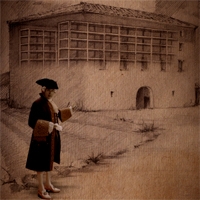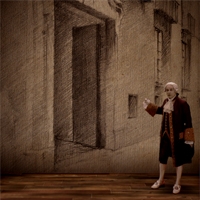During the 18th century, Valencia underwent a period of economic recovery, due in large part to the manufacturing of silk fabrics. This industry is calculated to have given work, directly or indirectly, to half of the inhabitants of the city and its surroundings, and to have shaped the layout and appearance of Velluters disctrict. The School of Silk Art was responsible for regulating the profession, growing further and further away from a guild framework and more toward proletarianization. However, the production was dominated by the merchants and depended largely on American demand.
At the end of the century, competition with silk fabrics from Lyon, other, lighter fabrics and more fashionable designs led to a decline in the industry.
-
 From Farmstead to Thread
From Farmstead to ThreadSilk is a natural secretion from the larvae of the butterfly Bombyx mori that was first used in prehistoric China to produce a smooth and resistent fiber which could then be woven into fabric. In Valencia, the process began in orchards, where workers cultivated mulberry trees whose leaves served as food for the caterpillars. The caterpilars were then raised in farmsteads, in large “beds” of wood and reeds, installed in the “stables.” When the larvae became fully developed they began to weave their cocoons, where they completed their metamorphoses. At this point, the cocoons were boiled in water so that their delicate filaments could be extracted with a brush and braided upon a spinning wheel, turning them into silk.
-
 From the Thread to the Spool
From the Thread to the SpoolBefore being spun, the silk had to be dyed. The skeins of silk were boiled in water and soap to bleach them and remove their impurities. Next, the dye was prepared by crushing natural ingredients and boiling them in water. Then the skeins were boiled again and submerged in a caustic substance that helped them hold their color. At this point, the skeins were placed in tubs along with the dye. Once dry, the they were wound onto spools.
-
 From the Spool to Fabric.
From the Spool to Fabric. -
 Joaquím Manuel Fos and moire
Joaquím Manuel Fos and moireFrom his humble origins, Joaquím Manuel Fos carved a path for himself in the silk industry thanks to his entrepreneurial spirit and indomitable curiosity. Eager to know firsthand the production techniques that were in vogue in France, he worked incognito in a factory in Leon for five years. Upon his return, he employed the best workers in his industry and perfected the techniques he had acquired, documenting his learnings in a celebrated treatise regarding moire fabric. From then onward, Manuel Fos’ life was linked College of the High Art of Silk, and in 1768, at the insistence of King Carlos III, he was named inspector general of Valencian silk.
-
 The School of the High Art of Silk
The School of the High Art of SilkOn the 18th of October, 1477, the Lloable Confraria o Almoina de l’Ofici de Velluters (Noble Brotherhood of the Silk Artisans) was established, placing its headquarters soon thereafter on the same street as the hospital. Valencia was known to attract a great number of Genovese masters who introduced the latest skills of their trade to the city, making it the epicenter of silk manufacture in the peninsula. Although Valencia later lost its dominance over silk production to Granada and Toledo, it was then regained in the eighteenth century. In 1686, via an honor bestowed by Carlos II, the guild was transformed into the Royal School of the High Art of Silk.
